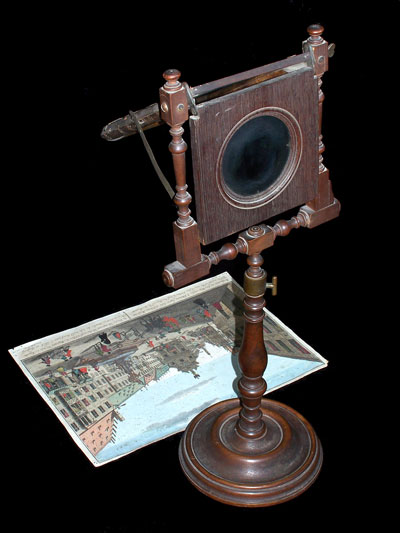Erin C. Blake’s Zograscope Reality
In her article “Zograscopes, Virtual Reality, and the Mapping of Polite Society in Eighteenth Century England,” Erin C. Blake begins by debunking the popular idea virtual reality is a recent concept. Rather, the use of technology to simulate the experience of inhabiting a particular space stretches as far back as the late 1600s. This idea took a unique turn in the form of the zograscope, a short-lived medium that reached the height of it’s popularity in England between 1740-1750. The device used the strategic placement of convex lenses to create a 3-D image of a print. To see this image, the viewer looked through a lens “suspended vertically in front of a mirror that was inclined at a 45-degree angle, and the whole assembly either mounted on a stand or inside a box that could be placed upon a parlor table” (Blake, 2). The zograscope print was placed upside down, as the curved lens of the device refracted the reflection of the image from the flat mirror. This allowed for viewers to see a three-dimensional rendering of the image from the print.
Blake notes that contrary to the later cinema mediums like the panorama and the cosmorama that were public in nature, the zograscope was highly private. This sense of separation from the places that the zograscope prints depicted created a space apart from their often-times crowded in-person counterpart. As a result, the zograscope appealed to what Blake describes as the “polite society” of England during its brief decade of popularity. Gentlemen and women who, rather than separating themselves from the rest of society on a strictly economic or geographical basis, chose to distinguish themselves through actions considered to be in good taste, i.e separate from the lower-classes. They could experience the great sites of London and Europe without the “physicality of the body, the actuality of sore feet while walking, of having to watch for traffic when crossing the street, of losing one’s way.” (Blake, 20).
The zograscope prints created during its decade of popularity were overwhelmingly depictions of London urban centers and less frequently cultural places popular for visitors in mainland Europe. The depiction of these places over other pastoral or natural scenes emulated what was considered in fashion, and therefore appropriate spheres for polite society to inhabit (20-21). Blake writes, “zograscope views were examples of the kind of space one ought to know about…divided up into equivalent units for ease of understanding and integrated by the observer into the whole…they encouraged the observer to perceive the prints with the discreteness and detachment of politeness” (21). According to Blake, this abstract concept of “politeness,” more than economic position or where one lived, dictated social behaviors and fashionable culture in the eighteenth century.

Zograscope Print. Image url: http://antiqueprintsblog.blogspot.com
In many ways, the zagroscope mirrors media techniques used by museums, archives, and historical institutions in the present. Most institutions are attempting to replicate the experience of the museum visit in the form of advanced websites or technologies that make the viewers feel like they are actually there. In a 2013 publication by the Smithsonian Institution’s Secretary G. Wayne Clough underscores the importance of the cultivating the museum “experience” outside of the institution. Web presence, the digitization of materials, and even virtual tours and field trips supplement the learning process at the Smithsonian and other cultural sites. The zograscope, although antiquated compared to the latest technology making these sites available in people’s homes, shows the universal desire for visitors to make unique opportunities available to them at all times and on their own terms.
